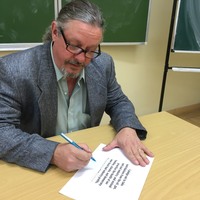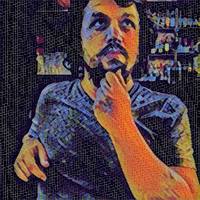Papers by Diana Prokofyeva

Person, Encounters, Paradigms Commitment, and Applications, eds. D. Prokofyeva and C. Patterson, 2023
This upload includes Auxier's contributions to the book Person, Encounters, Paradigms Commitment,... more This upload includes Auxier's contributions to the book Person, Encounters, Paradigms Commitment, and Applications, eds. D. Prokofyeva and C. Patterson.
In this essay Diana Prokofyeva considers “the photograph” in an unusual way – not just as an ordinary visual image and an imprint of reality, or as an expression of feelings, emotions and thoughts of a person. Photography as a common phenomenon of modernity is mostly seen through the filter of a person’s need for self-expression or social approval, to capture a memory, or as an attempt to establish social communication with the world. Here Prokofyeva analyzes the photograph as an existential phenomenon and as a way of avoiding death. In this case, the photograph as a phenomenon belongs to two “worlds” – the world of life and the world of death. This brings us to the main existential dichotomy of a human being’s life – the dichotomy between life and death, but against the background of our understanding of the inexorable progress of time and the mortality of everything. Therefore, Prokofyeva shows a connection between the “phenomenon” of photography, the experiential aspect, and this existential knowledge. In the background of this inquiry is a question about “the person” as an existential concern or care, a project or a hope. Does the person, in the existential sense, “survive” as image, in image, through image?
Analysis of Political Estrangement in Historical-Philosophical Reflection

RUDN Journal of Philosophy, Dec 15, 2019
Данная статья нацелена на выявление моральных дилемм, порождаемых технологическим прогрессом и ег... more Данная статья нацелена на выявление моральных дилемм, порождаемых технологическим прогрессом и его следствием-технологическим отчуждением в современном обществе. В ней анализируется взаимосвязь непосредственно феномена отчуждения, технологического прогресса и порождаемых ими в современном обществе моральных дилемм. Кроме возникновения новых моральноэкзистенциальных вопросов при непосредственном «столкновении» человека с технологиями в результате повсеместного внедрения их в нашу жизнь мы рассматриваем моральные дилеммы, возникающие вследствие технологического прогресса в таких сферах жизни, как политика, экономика и образование. Каждая из них ставит перед человеком более глубокую проблему-отчуждения от других людей, от родовой сущности и от самого себя, что позволяет нам обозначить данный вопрос не только как социальный, но и затрагивающий экзистенциальные вопросы. Ключевые слова: технологическое отчуждение, отчуждение, экономическое отчуждение, моральные дилеммы, манипуляция сознанием, образование Введение Переход к индустриальному обществу характеризовался появлением массового производства и, как следствие,-зарождением массовой культуры. Техника и технологии облегчали жизнь человека, освобождали его время и силы от ручного мануфактурного труда, придавали труду организованную форму. Доверяя монотонную, рутинную работу машинам, человек высвобождал большое количество своего времени, которое теперь могло быть потрачено на личностный рост и на межличностное общение. Однако, с другой стороны, повсеместное внедрение техники и технологий с середины XX века породило другую опасность-«порабощения» человека технологическим прогрессом и всевозможными техническими средствами. Цель Данная статья нацелена на выявление моральных дилемм, порождаемых технологическим прогрессом и его следствием-технологическим отчуждением в современном обществе. Кроме появления новых морально-экзистенциальных дилемм при непосредственном «столкновении» человека с технологиями в резуль

Common Ideals Shared by Eastern Orthodoxy and Erich Fromm's Humanism, 2020
There are shared humanistic tendencies in Erich Fromm's views and the ideas of Eastern Orthodoxy.... more There are shared humanistic tendencies in Erich Fromm's views and the ideas of Eastern Orthodoxy. The comparative method of this paper focuses on similarities between Fromm's humanistic psychoanalysis and Orthodox Christianity, while noting differences between them. In his works Fromm mentioned religious approaches, but he mostly referred to Protestantism (as a development from teachings of Martin Luther and John Calvin) and more rarely to Catholicism. Both streams have differences with Eastern Orthodoxy which is traditional for Russia. The individualism common to the western protestant model is contrasted with the community spirit, which is common to Russian culture and to the view of life of Russian Orthodoxy in particular. First, Fromm wrote about overcoming negative modes of life (such as estrangement or alienation) inherent to the first model, through adopting the second model. Second, humanistic views should be marked in ideas of Erich Fromm and Eastern Orthodoxy. The ideas of Erich Fromm and Eastern Orthodoxy are both based on a perception of a human being as a distinct whole personality, who should perceive as basic the values of self-development, love, creative self-realization, freedom, and responsibility. Also, free and whole personality cannot be formed without being a part of community of other persons, which is a very important point for both.
The article is devoted to the phenomenon of Estrangement and Engagement as its alternative. I wou... more The article is devoted to the phenomenon of Estrangement and Engagement as its alternative. I would like to offer my own classification of Estrangement which is divided into " existential " irresistible type and " historical " type which has its historical implementations. " Historical " types are closely connected to social life and have historical modifications during the history. To those types I refer political, economical and technological estrangement. I made a hypothesis that historical estrangement could be overcome by forms of 'willing engagement'. I also give an example of social Estrangement in modern Russia which is Estrangement from values of education and culture. That is why a discourse on peoples' estrangement (and engagement as its alternative) is very relevant as ever in the modern Philosophy.







Uploads
Papers by Diana Prokofyeva
In this essay Diana Prokofyeva considers “the photograph” in an unusual way – not just as an ordinary visual image and an imprint of reality, or as an expression of feelings, emotions and thoughts of a person. Photography as a common phenomenon of modernity is mostly seen through the filter of a person’s need for self-expression or social approval, to capture a memory, or as an attempt to establish social communication with the world. Here Prokofyeva analyzes the photograph as an existential phenomenon and as a way of avoiding death. In this case, the photograph as a phenomenon belongs to two “worlds” – the world of life and the world of death. This brings us to the main existential dichotomy of a human being’s life – the dichotomy between life and death, but against the background of our understanding of the inexorable progress of time and the mortality of everything. Therefore, Prokofyeva shows a connection between the “phenomenon” of photography, the experiential aspect, and this existential knowledge. In the background of this inquiry is a question about “the person” as an existential concern or care, a project or a hope. Does the person, in the existential sense, “survive” as image, in image, through image?
In this essay Diana Prokofyeva considers “the photograph” in an unusual way – not just as an ordinary visual image and an imprint of reality, or as an expression of feelings, emotions and thoughts of a person. Photography as a common phenomenon of modernity is mostly seen through the filter of a person’s need for self-expression or social approval, to capture a memory, or as an attempt to establish social communication with the world. Here Prokofyeva analyzes the photograph as an existential phenomenon and as a way of avoiding death. In this case, the photograph as a phenomenon belongs to two “worlds” – the world of life and the world of death. This brings us to the main existential dichotomy of a human being’s life – the dichotomy between life and death, but against the background of our understanding of the inexorable progress of time and the mortality of everything. Therefore, Prokofyeva shows a connection between the “phenomenon” of photography, the experiential aspect, and this existential knowledge. In the background of this inquiry is a question about “the person” as an existential concern or care, a project or a hope. Does the person, in the existential sense, “survive” as image, in image, through image?